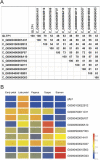Analysis of the floral transcriptome uncovers new regulators of organ determination and gene families related to flower organ differentiation in Gerbera hybrida (Asteraceae)
- PMID: 15781570
- PMCID: PMC1074362
- DOI: 10.1101/gr.3043705
Analysis of the floral transcriptome uncovers new regulators of organ determination and gene families related to flower organ differentiation in Gerbera hybrida (Asteraceae)
Abstract
Development of composite inflorescences in the plant family Asteraceae has features that cannot be studied in the traditional model plants for flower development. In Gerbera hybrida, inflorescences are composed of morphologically different types of flowers tightly packed into a flower head (capitulum). Individual floral organs such as pappus bristles (sepals) are developmentally specialized, stamens are aborted in marginal flowers, petals and anthers are fused structures, and ovaries are located inferior to other floral organs. These specific features have made gerbera a rewarding target of comparative studies. Here we report the analysis of a gerbera EST database containing 16,994 cDNA sequences. Comparison of the sequences with all plant peptide sequences revealed 1656 unique sequences for gerbera not identified elsewhere within the plant kingdom. Based on the EST database, we constructed a cDNA microarray containing 9000 probes and have utilized it in identification of flower-specific genes and abundantly expressed marker genes for flower scape, pappus, stamen, and petal development. Our analysis revealed several regulatory genes with putative functions in flower-organ development. We were also able to associate a number of abundantly and specifically expressed genes with flower-organ differentiation. Gerbera is an outcrossing species, for which genetic approaches to gene discovery are not readily amenable. However, reverse genetics with the help of gene transfer has been very informative. We demonstrate here the usability of the gerbera microarray as a reliable new tool for identifying novel genes related to specific biological questions and for large-scale gene expression analysis.
Figures

References
-
- Albert, V.A., Oppenheimer, D.G., and Lindqvist, C. 2002. Pleiotropy, redundancy and the evolution of flowers. Trends in Plant Science 7: 297-301. - PubMed
-
- Blein J-P., Coutos-Thévenot, P., Marion, D., and Ponchet, M. 2002. From elicitins to lipid-transfer proteins: A new insight in cell signalling involved in plant defence mechanisms. Trends in Plant Science 7: 293-296. - PubMed
Web site references
-
- http://www.ncbi.nlm.nih.gov/dbEST/dbEST_summary.html; NCBI database of Expressed Sequence Tags.
-
- http://sputnik.btk.fi; OpenSputnik EST database provided by the Centre for Biotechnology, Univ. of Turku, Finland.
-
- www.ebi.ac.uk/arrayexpress/; EBI microarray database.
Publication types
MeSH terms
Substances
LinkOut - more resources
Full Text Sources
Molecular Biology Databases
Research Materials
